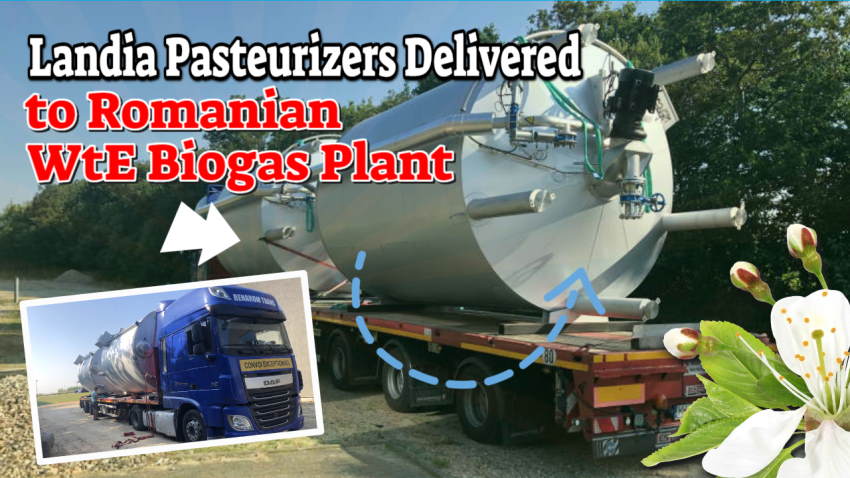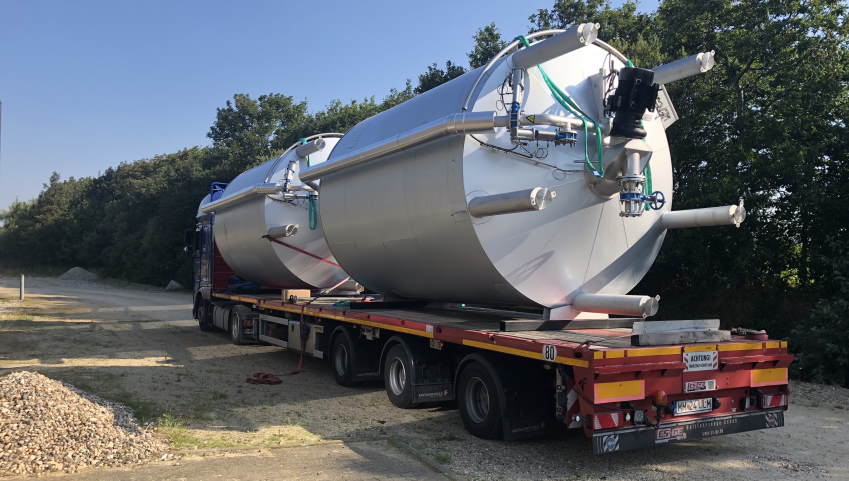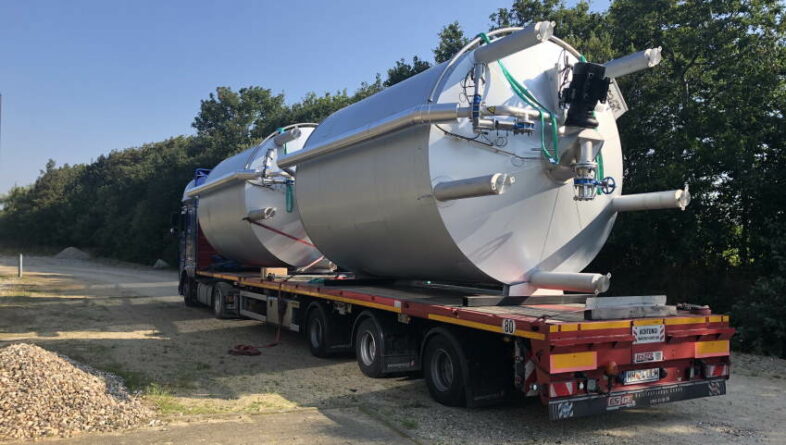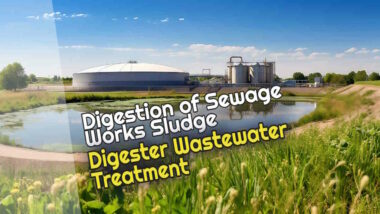Are you a biogas plant operator accepting ABP waste and concerned about the spread of diseases through conventional fertilizers and soil improvers? Here's a fact: Landia's pasteurisers can create Animal By-products Regulations (ABP) – compliant pathogen-risk-free product outputs.
This blog will offer insights into how these devices deactivate harmful organisms to ensure safe, high-quality soil improver and fertiliser products. Intrigued? Let's dig deeper!
Importance of ABP Pasteurizers for Fertilizers and Soil Improvers
Animal By-products Regulations (ABP) – compliant Landia pasteurizers play a crucial role in ensuring the safety and quality of anaerobic digestion process digestate-derived fertilizers and soil improvers by effectively eliminating indicator microorganisms and biological hazards.
Inactivation of indicator microorganisms and biological hazards
Pasteurization plays a crucial role in eliminating harmful microorganisms and biological hazards present in organic fertilizers and soil improvers. Landia pasteurizers ensure thorough deactivation of these potential threats, making the products safe for use and they can once pasteurised be sold on the open market.
In Landia pasteurizers targeted heating processes break down the structure of indicator microorganisms such as E.coli, Salmonella or Campylobacter, thereby neutralising their pathogenic properties. The same applies to biological hazards like fungi or viruses that can also pose health risks if pathogenic organisms were to enter the food chain via crops nurtured with untreated soil amendments.
Successful neutralisation protects against diseases which may be transmitted through contaminated fertilisers. Hence, using Landia pasteurizers makes your nutrient-rich organic matter safe and fit for use without compromising its beneficial qualities.
Use in organic fertilizers and soil improvers
Landia Pasteurizers play a vital role in the production of organic fertilizers and soil improvers. These pasteurizers are specifically designed to ensure that all dangerous microorganisms and biological hazards are effectively deactivated, making the products safe for agricultural use.
The use of Landia Pasteurizers ensures compliance with UK and most international regulations and standards, guaranteeing the quality and safety of organic fertilizers and soil improvers.
With their application in the anaerobic digestion/ biogas production process, these pasteurizers contribute to sustainable agriculture practices by providing pathogen-free solutions that enhance nutrient release and improve soil health.
Compliance with regulations and standards
Landia Pasteurizers for ABP Pathogen Free Fertilizers & Soil Improvers comply with strict regulations and standards set by environmental agencies and governing bodies. The pasteurization process ensures the inactivation of indicator microorganisms and biological hazards, making the products safe to use.
This compliance is particularly important when it comes to organic fertilizers and soil improvers, as they need to meet specific criteria for PAS certification. With Landia Pasteurizers, you can have confidence that your products adhere to these regulations while providing high-quality solutions for sustainable agriculture practices.

Benefits of Landia Pasteurizers for ABP Pathogen-Risk-Free Fertilizers & Soil Improvers
Landia Pasteurizers provide significant benefits for ABP Pathogen Risk Free Fertilizers & Soil Improver manufacturers, including enhanced product hygiene and quality, reduced odour, and better stability, and reduced risk of disease transmission.
Enhanced safety and quality of products
Landia Pasteurizers provide a significant benefit by enhancing the safety and quality of ABP pathogen-free fertilizers and soil improvers. The use of these pasteurizers ensures that indicator microorganisms and biological hazards are effectively inactivated, minimizing the risk of contamination.
This is especially crucial for organic fertilizers and soil improvers made from food waste digesters, abattoir digesters etc., as they must comply with strict ABP regulations and standards. With Landia Pasteurizers, you can be confident in the safety of your products, providing peace of mind to consumers while maintaining high-quality standards throughout the production process.
Moreover, these pasteurizers also contribute to increased digestion rates/ higher biogas yield, while also:
- reducing the risk of disease transmission and
- ensuring long-lasting effectiveness from digestate soil improvers and biogas plant fertilisers for all agricultural, horticultural and gardening needs.
Increased biogas yield and process stability
Landia Pasteurizers offer significant benefits when it comes to increasing the biogas yield a digester of ABP pathogen-free fertilizers and soil improvers. With their advanced processing methods, these pasteurizers ensure that indicator microorganisms and biological hazards are effectively inactivated, resulting in enhanced safety, stability and quality of products.
By eliminating harmful pathogens, Landia Pasteurizers reduce the risk of disease transmission, making AD Plant fertilizers and soil improvers safer for use.
Additionally, the improved stability of the output ensures that the nutrients in these products remain intact over time, providing consistent results when used in agriculture or gardening projects.
Reduced risk of disease transmission
Landia Pasteurizers offer a significant benefit of reducing the risk of disease transmission in ABP pathogen-free fertilizers and soil improvers. By subjecting these products to a controlled pasteurization process, Landia effectively eliminates harmful microorganisms that could potentially spread diseases.
This is particularly important for organic fertilizers and soil enhancers, as they would otherwise contain biological hazards that pose a risk to human health and livestock. With Landia Pasteurizers, you can ensure enhanced safety and quality of your products, making them safer for use in agriculture and gardening without the worry of disease transmission.
Application and Usage of Landia Pasteurizers
Landia Pasteurizers are suitable for all plant types and gardening needs. Proper handling and storage of pasteurized products ensure the safety and quality of fertilizers and soil improvers.
Find out more about how Landia Pasteurizers can enhance your agricultural practices by reading on!
Suitable for all plant types and gardening needs
Landia Pasteurizers are versatile and suitable for all plant types and gardening needs. Whether you're growing fruits, vegetables, flowers, or herbs, these pasteurizers can effectively process your fertilizers and soil improvers.
With their advanced technology and efficient performance, Landia Pasteurizers ensure that your products meet the highest safety standards without compromising on quality. You can rely on these pasteurizers to optimize nutrient release and enhance the health of your plants while reducing the risk of disease transmission.
Proper handling and storage of pasteurized products
Landia Pasteurizers offer efficient and effective methods for pasteurizing ABP pathogen-free fertilizers and soil improvers.
However, once the products have been pasteurized, it is important to follow proper handling and storage protocols. Here are some guidelines to ensure the safety and quality of the pasteurized products:
- Store the pasteurized products in a clean and dry area, away from direct sunlight and extreme temperatures.
- Use appropriate containers or packaging that is sealed tightly to prevent contamination or moisture ingress.
- Label the containers clearly with necessary information such as product name, date of pasteurization, and expiration date.
- Follow recommended temperature and humidity conditions for storage, if specified.
- Regularly inspect the stored products for any signs of damage, spoilage, or pest infestation.
- Keep a log of inventory to track the quantity and movement of pasteurized products.
- Train personnel on proper handling procedures to minimize risks of cross-contamination or mishandling.
Conclusion
In conclusion, Landia Pasteurizers are an essential tool for ensuring the safety and quality of ABP Pathogen Free Fertilizers & Soil Improvers. With their ability to effectively inactivate indicator microorganisms and biological hazards, these pasteurizers provide increased shelf life and stability for these products.
By reducing the risk of disease transmission and complying with regulations and standards, Landia Pasteurizers play a crucial role in sustainable agriculture and biotechnology practices.
Landia Pasteurizers have been delivered to a Romanian WtE Biogas Plant. Pasteurizers fitted to anaerobic digestion plants as they will be at this plant in Romania, perform the function of destroying any unwanted disease-carrying organisms, bacteria, and virus particles which might be in the incoming waste fed into the biogas plant.
After pasteurizing the output for the AD Plant (digestate) can be used for a far wider range of fertilizer and soil-improvement uses and hence there are many good reasons for installing pasteurizers at biogas plants.
The plug-in-and-play Biochop can treat both slaughterhouse and food waste for flows in excess of 300 tonnes per day.
Delivered complete with a user-friendly control system for regulation, monitoring and registration of the hygienisation process, the Landia BioChop also benefits from having no moving parts inside the pasteurizers. There is no need to enter the tank to carry out maintenance.
Landia Pasteurizers Delivered to Romanian WtE Biogas Plant
Archived Press Release 2 September 2020:
New Romanian waste-to-energy plant to benefit from Landia pasteurizers.
For a new state-of-the-art waste-to-energy biogas plant in Romania, Landia has been chosen to supply two of its 25m3 pasteurizers.
The Landia BioChop units will play a crucial role in eliminating biohazards by heating biomass to a minimum of 72°C for one-hour batch processes – allowing the final digestate to be utilized safely as a high-quality fertilizer.

Equipped with a Landia chopper pump and a Landia side-entry mixer, the plug-in-and-play Biochop can treat both slaughterhouse and food waste for flows in excess of 300 tonnes per day.
Delivered complete with a user-friendly control system for regulation, monitoring and registration of the hygienisation process, the Landia BioChop also benefits from having no moving parts inside the pasteurizers, so there is no need to enter the tank to carry out maintenance.
In addition to the externally-mounted chopper pump (that reduces particle sizes) and side-entry propeller mixer, the Landia pasteurizer is also supplied with an integral heating jacket as part of its very solid and compact design for high treatment capacity.

In the lower part of the BioChop, the Landia chopper pump ensures the comprehensive circulation of the biomass, preventing dead zones in the tank. At the same time, it constantly reduces particle size for optimization of the heating process and the supply of suitably homogenised feedstock for the digesters. The chopper pump can also be used for emptying the tank – typically achieved in just a few minutes.
Meanwhile, the angled, side-entry Landia mixer further enhances movement in the tank, with every unit, including the propeller, customised for each specific project.
PR ends
Biogas in Romania
The nation is no stranger to anaerobic digestion and biogas production. In Romania, large and small capacity AD Plants were built as part of the national plan for biogas 1958-1982:
- Coupled with water treatment plants for sewage sludge treatment prior to disposal.
- As the development of facilities for use in the farming sector (including small biogas units).
The results of the program which ran for 30 years was the development of a total of 400 facilities, with a total energy production of 0.18 TWh*year-1.
The main drawback of this project was the fact that the owner was the State, through the state-owned companies. After the fall of the regime in 1989, a long process of reorganisation, privatisation and liquidation of those companies occurred, having, as a result, a gradual depreciation and demolition of the worn-out biogas facilities. Virtually, no plant from the 400 developed still existed in 2008.
The opportunities for biogas production in the BiG>East target countries are very high, especially in the waste treatment (WtE) sector. Implementation will enable efficient and environmentally sustainable waste disposal, while at the same time generating a significant amount of energy in a manner that aids the region’s responsibility to reduce and offset its carbon footprint. Generally, the countries involved have good infrastructure and framework for waste collection as well as lots of potential in growing energy crops [coupled with animal slurry digestate as fertiliser].
Biogas systems using energy crops as feedstock are robust simple and reliable technology. Waste-treating biogas systems are more complicated because of contaminant removal, but the working principle is the same. The organic material is broken down in large tanks in an anaerobic process resulting in the formation of methane gas which is then used as a fuel to drive an electric generator.
Greenhouse gas benefits are derived from the capturing of methane gas which would otherwise be liberated in a landfill process and further, the conversion of methane to CO2 in the combustion process. This is an important issue as CO2 is a much less potent greenhouse gas than methane. Although CO2 is released during energy production the carbon is largely offset by the carbon sequestered in the growing process of the organics in the waste and the agricultural products. The spent slurry material at the end of the biogas process known as digestate can be separated into a solid material which forms rich and productive compost, and a liquid rich in nutrients suitable for direct application to farmland as a liquid fertiliser.
The conditions for biogas production in Bulgaria, Croatia, Greece, Latvia, Romania, and Slovenia are very favourable. However, the question is which technologies are most promising for the utilisation of the produced biogas?
In general, biogas is an energy carrier which can be used for several energy applications. This includes electricity generation, heat production, combined heat and power production (CHP), and transport applications. These technologies are described in the BiG>East Handbook which is available on the BiG>East website www.big-east.eu.
Biogas upgrading to natural gas quality (biomethane) and feed-in into the natural gas grid is described in the BiG>East report “Biogas purification and assessment of the natural gas grid in Southern and Eastern Europe”, also available at the BiG>East website. Anyhow, this technology is rather new and needs more development. Implementing the biogas upgrading technology can only be recommended in very special cases and in countries with existing experience in biogas production like in Germany where 22 biogas upgrading plants are currently being installed.
When the waste streams are correctly sorted and processed there is no need for landfill and the goal must be to completely stop disposing of waste this way.
With the right incentives, programs and engineering, the outputs from waste should be:
(1) recycled/reused material,
(2) energy,
(3) compost and fertiliser, or
(4) products for incineration (in small cases where the first two methods are unachievable).
Biogas systems offer all target countries a primary means of waste disposal, extracting the organic and biodegradable fractions from the waste. The non-biodegradable components extracted can be filtered into recycling facilities. The systems can be adapted in size and design to meet all the listed applications whether they are municipal, industrial or agricultural wastes. via www.big-east.eu
Landia Pasteurizer FAQs
1. What are ABP pathogen-risk-free fertilizers and soil improvers?
ABP stands for Animal By-Products, which are materials derived from animals that are not intended for human consumption. ABP pathogen-risk-free fertilizers and soil improvers are made from these by-products but have undergone a pasteurization process to remove any potential pathogens or harmful contaminants.
2. How do Landia pasteurizers ensure that ABP pathogen-free fertilizers and soil improvers are safe?
Landia pasteurizers use advanced heating technology to raise the temperature of the materials to a level that kills off any harmful bacteria, viruses, or parasites. This ensures that the resulting products are safe to handle and use in agricultural settings without posing a risk to humans, animals, or plants.
3. Can I use Landia pasteurizers for other types of material besides ABP?
Yes, Landia pasteurizers can be used for various other types of organic materials as well. The equipment is designed to effectively heat and treat different substances such as sludge, food waste, and organic residues in order to eliminate pathogens and optimize their usability in different industries.
4. Are Landia pasteurizers suitable for large-scale commercial operations?
Yes, Landia offers a range of models with varying capacities to cater to different production volumes. Their pasteurizer systems can be customized according to specific requirements and integrated into existing processing lines or used as standalone units for large-scale commercial operations producing ABP pathogen-free fertilizers & soil improvers efficiently.
First published 3 September 2020.





Very Informative Website. Please visit if you like to know more about Gas Stove
https://allgasstoves.com/